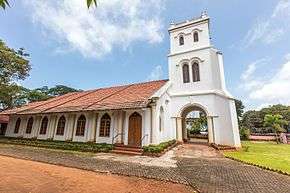St. Paul's Church, Mangalore
| St. Paul's (Military Church) | |
|---|---|
| St. Paul's Church | |
 Entrance of the church | |
| Coordinates: 12°51′42″N 74°50′15″E / 12.86165°N 74.8375°E | |
| Location | Central Maidan, Mangalore |
| Country | India |
| Denomination | Church of South India |
| Tradition | Anglican |
| History | |
| Consecrated | 1843 |
| Architecture | |
| Style | English Baroque |
| Groundbreaking | 1841 |
| Completed | 1843 |
| Construction cost | ₨ 7,215 |
| Administration | |
| Diocese | Karnataka Southern Diocese |
St. Paul's Church is an Anglican church in Mangalore, India.
St. Paul's Church is located at the south-west corner of the Nehru Maidan (formerly the Central Maidan) in Mangalore. It was the first Protestant church to be raised in the South Kanara region. St. Paul's was originally a garrison church, raised by the British India army of the Madras Government, built using prison labour.[1][2] St. Paul's is an imposing structure amidst the chaos of the fish market, service bus stand, and the State Bank of India.[3]
History
Following the Coorg rebellion of 1837, the city of Mangalore was fortified and the British army unit based there was strengthened. This resulted in a need for the church to meet the spiritual and moral needs of the British soldiers and citizens. In 1841, garrison chaplain Rev. R. W. Whitford appealed to the Government of Madras to construct a church in Mangalore, which was accepted. In 1842, Rev. Alfred Fennell succeeded Rev. Whitford. The church building was completed in 1842, and consecrated by George Spencer, Church of England, Bishop of Madras, on 5 January 1843.[2][1]
Construction
The construction site of the St. Paul's Church, Mangalore, was at the Fort St Sebastian, the main seat of British power in Canara, on a 0.5-acre (0.2 ha) plot.[3]
The initial budget was ₨ 5,128, and was to accommodate 120 people. However, as a result of rising costs and insufficient funds it was decided to reduce the capacity of the church building to 100. The building works were initiated in 1842 by Rev. Alfred Fennel, and the church building was completed and was furnished before the arrival of Bishop Spencer to Mangalore, and was consecrated on 5 January 1843.[2] The final cost of construction was ₨ 7,215. The church was constructed using prison labour.[4]
After construction, the internal area of the church is 57 by 25 feet (17.4 m × 7.6 m), with sufficient place allowed for the pulpit, sanctuary, lectern and clergy stall, could seat nearly 100 people.[4]
%2C_by_Rev._Frank_Penny's_Book_'The_Church_in_Madras'.jpg)
Clock Tower
Extensive repairs to the church were undertaken in 1897, during which the church tower was added.[3][1] The church tower of St. Paul's has a clock, with two dials. The clock was made in the Mangalore workshop of the Basel Mission, and installed by its German missionaries. The clock continues to function accurately. After the demolition of clock tower in Hampankatta, the clock tower of St. Paul's is the only remaining clock tower in Mangalore.[2]
Basel Mission
The German missionaries of the Basel Mission worshipped in St. Paul's Church until 1862, when the Balmatta Hill Shanti Church (now Cathedral) was established.
Present Status

In 1947, after Indian Independence, St. Paul's became part of the Church of South India, under the CSI North Kerala Diocese. In 1971, it was transferred to the Karnataka Southern Diocese. It presently has around 115 families as members, and also strives to meet the spiritual needs of locals, and domestic and foreign visitors.[2] In 2003, a community hall, located at the rear of the church, was inaugurated by Rev. C. L. Furtado, CSI Bishop of Mangalore.[3]
St. Paul's Cemetery
St. Paul's Cemetery is located on Old Kent Road,[5] near the railway tracks of the Mangalore Central Station, and is the resting place of many officers of the East India Company and British citizens. A notable grave is that Brigadier General John Carnac, Commander-in-Chief of forces at Bengal, who in 1761 defeated Shah Zaddar, and died in Mangalore, aged 84, on 29 November 1800. The church records the officers of the East India Company who died in battle from 1855, and burial records from 1859.[2][6]
References
- 1 2 3 Nandalike, Walter (26 March 2006). "Exclusive St. Paul's - Canara's First Protestant Church" (Mangalore). Daji World. Retrieved 13 August 2015.
- 1 2 3 4 5 6 Fernandes, Ronald Anil (3 June 2011). "A mute witness to history" (Bangalore). Deccan Herald. Retrieved 13 August 2015.
- 1 2 3 4 Shet, LJ S (29 October 2010). "Old British 'Military Church' of M'lore" (Deccan Herald). Deccan Herald. Retrieved 13 August 2015.
- 1 2 Penny, Frank (1922). The Church in Madras : being the History of the Ecclesiastical and Missionary Action of the East India Company in the Presidency of Madras From 1835 to 1861: Volume III (PDF). London: John Murray. p. 98. Retrieved 13 August 2015.
- ↑ "Wiki adds Mangaluru's 42 historic pictures". The Times of India. 18 September 2016. Retrieved 4 February 2017.
- ↑ "20-foot tall obelisk in memory of Brigadier-General John Carnac" (Mangalore). Deccan Herald. 10 June 2011. Retrieved 13 August 2015.
Further reading
- Penny, Frank (1922). The church in Madras : being the history of the ecclesiastical and missionary action of the East India Company in the Presidency of Madras in the seventeenth and eighteenth centuries. 3. London: John Murray. pp. 96–100.
External links
- Basel Mission. "St. Paul's Church, Mangalore". Basel Mission Archives. Nineteenth-century picture of the church
| Wikimedia Commons has media related to St. Paul's Church, Mangalore. |